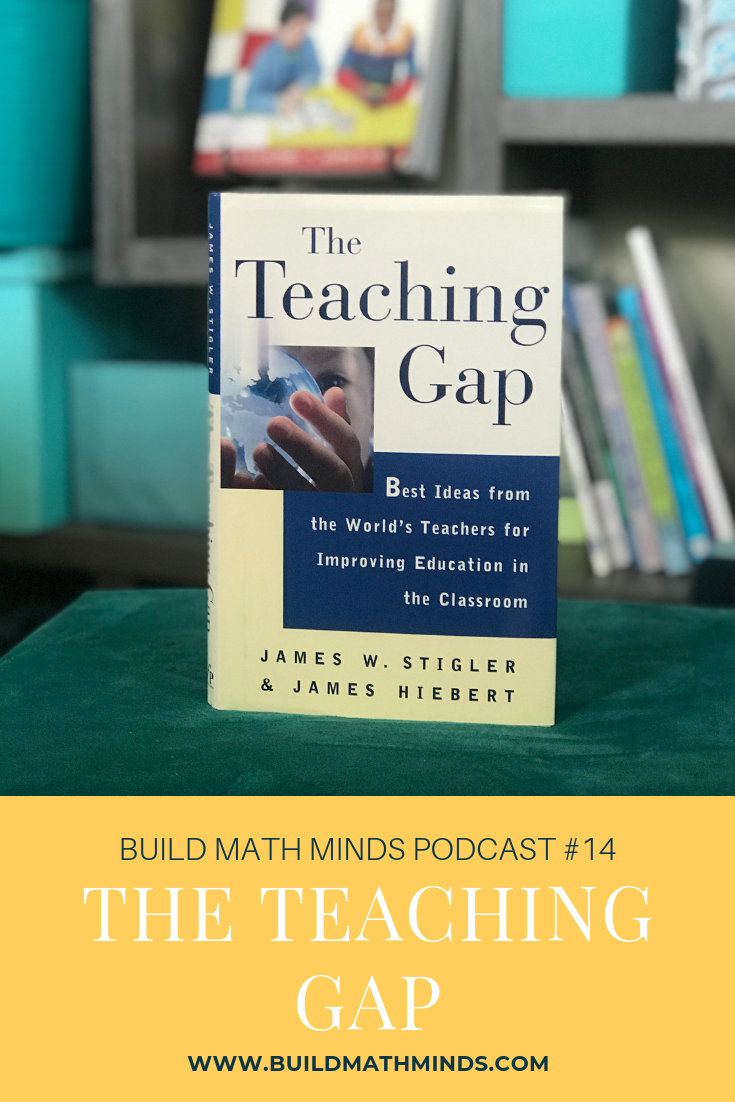Resources mentioned in this episode:
The Teaching Gap by Stigler & Hiebert
2019 Virtual Math Summit Registration
Welcome fellow Recovering Traditionalists to Episode 14. Today we are looking at The Teaching Gap
Today’s insight comes from a book that I think should be required reading for all educators and parents: The Teaching Gap: Best Ideas from the World’s Teachers for Improving Education in the Classroom by Stigler & Hiebert.
As much as I hate comparing the education system in our country to other countries, this book is so powerful. One of the reasons I hate doing comparisons is that there are so many factors that go into the education of a child and the culture of the country plays a large role in those factors. However, we shouldn’t focus on the things we can’t control and instead we need to focus on the things we can control. We do have control over what happens in our classrooms, in our schools, in our districts. The way we teach mathematics is up to us. This book was eye opening research about the stark differences between what happens in math class in the U.S compared to Japan and Germany.
In the Preface they state:
“…the teaching gap we describe refers to more than cross-cultural teaching differences. It refers to the differences between the kinds of teaching needed to achieve the educational dreams of the American people and the kind of teaching found in most American schools. Although many of the American teachers we observed were highly competent at implementing American teaching methods, the methods themselves were severely limited…The United States is always reforming but not always improving. The most alarming aspect of classroom teaching in the United States is not how we are teaching now but that we have no mechanism for getting better. Without such a mechanism, the teaching gap will continue to grow.”
They go on in the book to talk about the differences in teaching practice and why it matters. But in the latter chapters Stigler & Hiebert discuss how we can actually make improvements. On pages 131-137 they discuss 6 Principles for Gradual, Measurable Improvement. I’m just going to list them out here and I want you to think about how much your district or school is doing these. This book was written 20 years ago. Have you been doing these things? Has there been gradual, measurable improvement?
Principle #1: Expect Improvement to Be Continual, Gradual, and Incremental
Principle #2: Maintain a Constant Focus on Student Learning Goals
Principle #3: Focus on Teaching, NOT Teachers
Principle #4: Make Improvements in Context
Principle #5: Make Improvement the Work of Teachers
Principle #6: Build a System That Can Learn from Its Own Experience
They discuss how time needs to be given to teachers in order to do these things. It isn’t the work of a single teacher. Teachers need to work together as they focus on these principles.
If you are trying to make a change in the teaching of mathematics in your school, I’d highly recommend you get the book The Teaching Gap. It is full of eye-opening data along with ideas for change.
I’d also like to encourage you to get registered for the free Build Math Minds Virtual Summit. The Virtual Summit is a free online professional development conference for elementary teachers. We have almost 40 presenters who are sharing their knowledge about best practices for teaching mathematics in elementary grades. It’s a great way to get a group of teachers from your school together to watch PD by the Pool (or wherever you want) this summer. You can go to buildmathminds.com/virtual-math-summit to get registered.
Subscribe and Review in iTunes
Hey, are you subscribed to the Build Math Minds Podcast, yet? If you’re not, make sure to do that today because I don’t want you to miss any episodes! Click here to subscribe to the podcast in iTunes.
While you’re there, don’t forget to leave a review on iTunes too. I would love to know your thoughts and how we can make sure that we give you content that you will really enjoy.
To leave a review, head over to iTunes and click on “Ratings and Reviews” and “Write a Review.” I can’t wait to hear your thoughts about the podcast.




